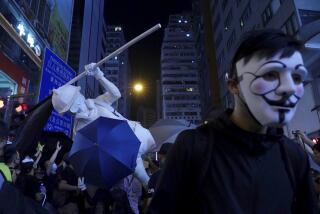Park Will Soon Replace Kowloon Slum
- Share via
HONG KONG — Huddled in unbelievable squalor just feet beneath the roaring approach path to Hong Kong’s international airport, inhabitants of the notorious “Cancer of Kowloon” cannot believe their luck.
The so-called Walled City, a slum so densely packed that multistory buildings lean precariously against one another, is soon to disappear.
The area--where police warn tourists and Hong Kong’s overseas residents never to venture alone--will pass into history within two years, after the government rehouses and compensates the estimated 30,000 dwellers and razes the tenements.
Officials say its dark, stinking alleyways will make way for a tree-lined urban park.
Real estate analysts, however, question the decision to turn the old Walled City into a park when building land in Hong Kong is at a premium.
One analyst admitted, however, that it was the only way China and Hong Kong could resolve a protracted historical dispute over the area dating back nearly a century.
When Britain expanded its control of the Kowloon Peninsula under the 1898 Convention of Beijing, it agreed that China should retain control over the Walled City, then a Chinese garrison, as long as it presented no threat to Hong Kong.
London says that condition was breached within a year, when the garrison became involved in an anti-British uprising and the Chinese troops were evicted.
Beijing never recognized this unilateral act and protested from time to time over British attempts to govern the Walled City.
The site eventually became an embarrassment with neither side showing much interest in it.
Left alone, it became a virtual no-go area for police where opium dens, gambling parlors and seedy whorehouses flourished.
As late as 1963, Beijing formally protested on behalf of residents when Hong Kong first proposed clearing the City--by then walled in name only. The crumbling ramparts went during World War II, when Japanese occupation troops pulled them down and used the rubble to expand the nearby airport.
Only the 1984 signing of the so-called Joint Declaration, under which Britain agreed to hand back Hong Kong to Chinese rule, cleared the way for resolving the issue.
Three years later, the government announced its decision to turn the Walled City into a park, paying compensation to the residents and rehousing them in modern apartments if they wished.
“I never knew what they were deciding for the Walled City. In fact, I never expected it would be demolished so soon. We were rather shocked in 1987 when the government announced it was going to clear the city,” said Chan Hip-ping, vice chairman of the Walled City Residents’ Assn., known in Cantonese as the Kaifong.
The Kaifong office is at the top of a dark stairwell which, unlike the rest of the area, at least benefits from adequate refuse collection.
Elsewhere, the alleys are just wide enough to walk in single file, and rats run at shoulder-height along thin ledges.
Gutters double as open sewers and water drips from live electric cables that hang so low that residents have to almost bend over double to make their way through.
“Most of the residents are happy to move out--their living conditions will definitely improve compared to living here,” Chan said. “Conditions are quite bad here--a family of four will share a flat measuring only 100 square feet.”
Until families began to move out last year, the Walled City was also home to three drug-addiction-treatment centers.
Briton Jackie Pullinger, who has run one center for years, remembers when every alley into the city was watched by messengers who informed their criminal “big brothers” of every visitor or unfamiliar face.
Pullinger is moving out soon along with the other voluntary agencies.
Chan said he never understood why the government had neglected the Walled City for so long.
“Until 1987, when they announced the clearance project, we really felt we had been abandoned and the city came to have a very bad reputation.
More to Read
Sign up for Essential California
The most important California stories and recommendations in your inbox every morning.
You may occasionally receive promotional content from the Los Angeles Times.












